Business Environment Analysis of Nestle: A Comprehensive Report
VerifiedAdded on 2020/06/05
|13
|3647
|46
Report
AI Summary
This report provides a detailed business environment analysis of Nestle, a major food company in the UK. It begins with an introduction to the business environment and its impact on company performance, followed by an examination of Nestle's organizational functions, including finance, marketing, human resources, and production. The report then explores the positive and negative impacts of the macro environment, such as political, legal, technological, economic, environmental, and social factors, on Nestle's operations. A SWOT analysis is conducted to evaluate Nestle's strengths, weaknesses, opportunities, and threats, and the interrelation of these factors with the external macro environment. The report concludes with a summary of the key findings and includes a list of references.
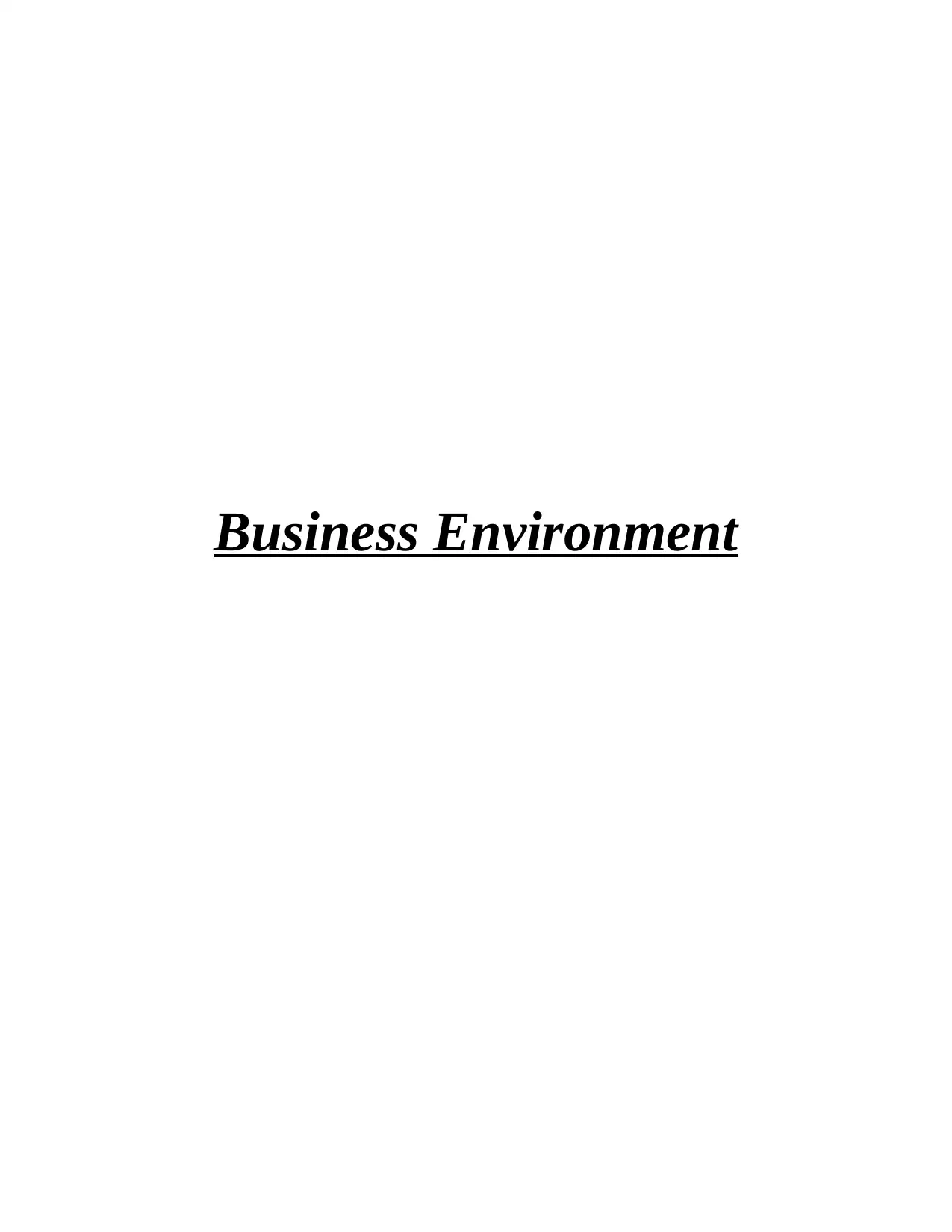
Business Environment
Paraphrase This Document
Need a fresh take? Get an instant paraphrase of this document with our AI Paraphraser
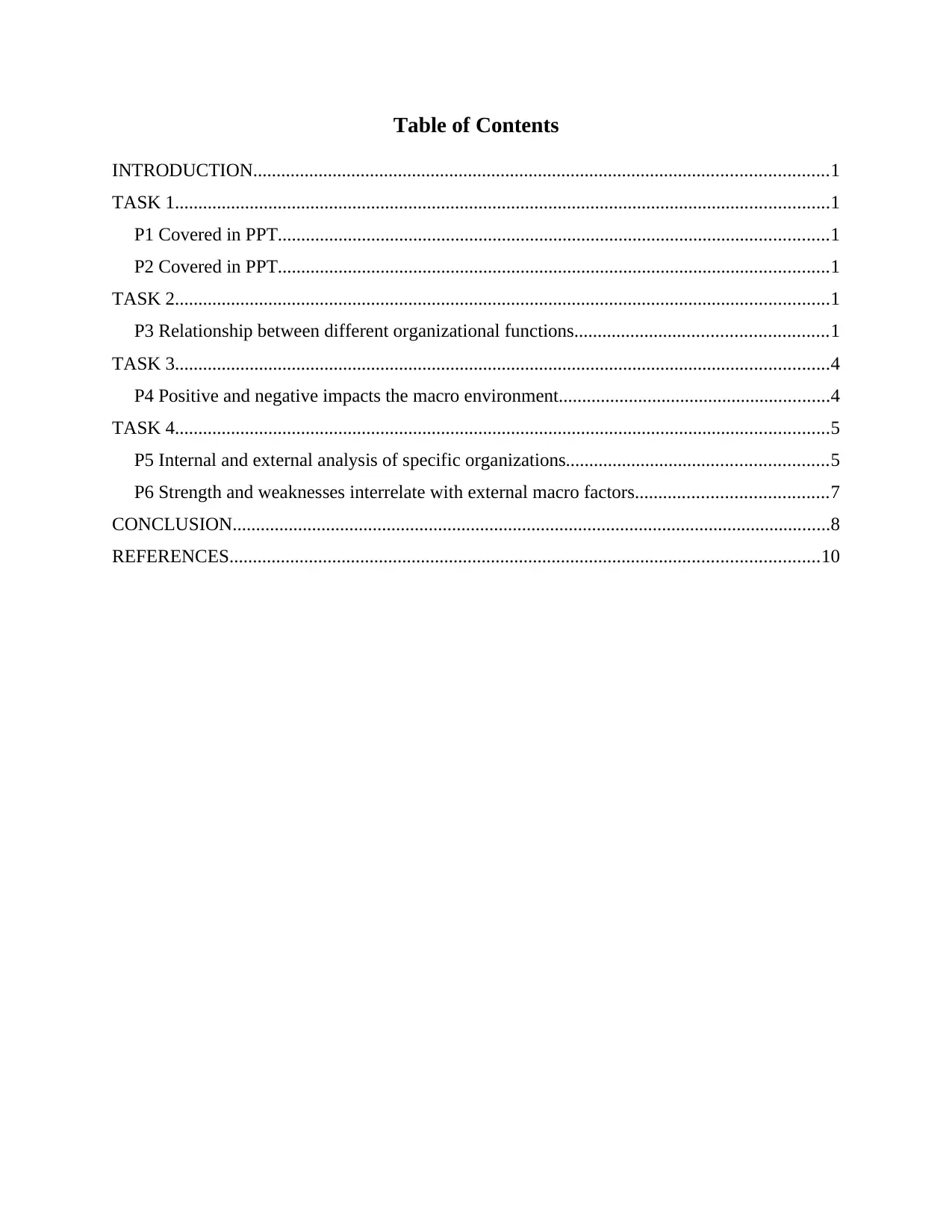
Table of Contents
INTRODUCTION...........................................................................................................................1
TASK 1............................................................................................................................................1
P1 Covered in PPT......................................................................................................................1
P2 Covered in PPT......................................................................................................................1
TASK 2............................................................................................................................................1
P3 Relationship between different organizational functions......................................................1
TASK 3............................................................................................................................................4
P4 Positive and negative impacts the macro environment..........................................................4
TASK 4............................................................................................................................................5
P5 Internal and external analysis of specific organizations........................................................5
P6 Strength and weaknesses interrelate with external macro factors.........................................7
CONCLUSION................................................................................................................................8
REFERENCES..............................................................................................................................10
INTRODUCTION...........................................................................................................................1
TASK 1............................................................................................................................................1
P1 Covered in PPT......................................................................................................................1
P2 Covered in PPT......................................................................................................................1
TASK 2............................................................................................................................................1
P3 Relationship between different organizational functions......................................................1
TASK 3............................................................................................................................................4
P4 Positive and negative impacts the macro environment..........................................................4
TASK 4............................................................................................................................................5
P5 Internal and external analysis of specific organizations........................................................5
P6 Strength and weaknesses interrelate with external macro factors.........................................7
CONCLUSION................................................................................................................................8
REFERENCES..............................................................................................................................10
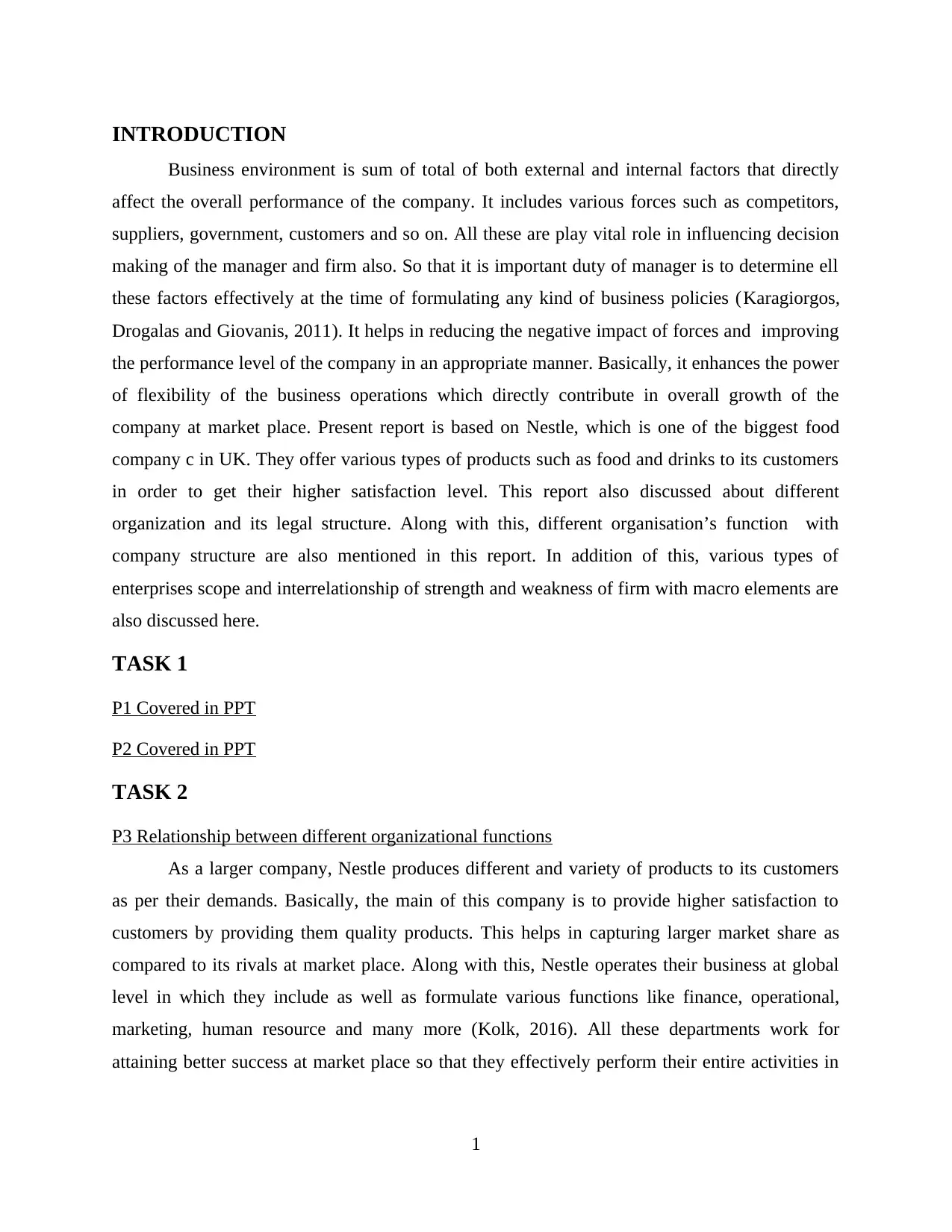
INTRODUCTION
Business environment is sum of total of both external and internal factors that directly
affect the overall performance of the company. It includes various forces such as competitors,
suppliers, government, customers and so on. All these are play vital role in influencing decision
making of the manager and firm also. So that it is important duty of manager is to determine ell
these factors effectively at the time of formulating any kind of business policies (Karagiorgos,
Drogalas and Giovanis, 2011). It helps in reducing the negative impact of forces and improving
the performance level of the company in an appropriate manner. Basically, it enhances the power
of flexibility of the business operations which directly contribute in overall growth of the
company at market place. Present report is based on Nestle, which is one of the biggest food
company c in UK. They offer various types of products such as food and drinks to its customers
in order to get their higher satisfaction level. This report also discussed about different
organization and its legal structure. Along with this, different organisation’s function with
company structure are also mentioned in this report. In addition of this, various types of
enterprises scope and interrelationship of strength and weakness of firm with macro elements are
also discussed here.
TASK 1
P1 Covered in PPT
P2 Covered in PPT
TASK 2
P3 Relationship between different organizational functions
As a larger company, Nestle produces different and variety of products to its customers
as per their demands. Basically, the main of this company is to provide higher satisfaction to
customers by providing them quality products. This helps in capturing larger market share as
compared to its rivals at market place. Along with this, Nestle operates their business at global
level in which they include as well as formulate various functions like finance, operational,
marketing, human resource and many more (Kolk, 2016). All these departments work for
attaining better success at market place so that they effectively perform their entire activities in
1
Business environment is sum of total of both external and internal factors that directly
affect the overall performance of the company. It includes various forces such as competitors,
suppliers, government, customers and so on. All these are play vital role in influencing decision
making of the manager and firm also. So that it is important duty of manager is to determine ell
these factors effectively at the time of formulating any kind of business policies (Karagiorgos,
Drogalas and Giovanis, 2011). It helps in reducing the negative impact of forces and improving
the performance level of the company in an appropriate manner. Basically, it enhances the power
of flexibility of the business operations which directly contribute in overall growth of the
company at market place. Present report is based on Nestle, which is one of the biggest food
company c in UK. They offer various types of products such as food and drinks to its customers
in order to get their higher satisfaction level. This report also discussed about different
organization and its legal structure. Along with this, different organisation’s function with
company structure are also mentioned in this report. In addition of this, various types of
enterprises scope and interrelationship of strength and weakness of firm with macro elements are
also discussed here.
TASK 1
P1 Covered in PPT
P2 Covered in PPT
TASK 2
P3 Relationship between different organizational functions
As a larger company, Nestle produces different and variety of products to its customers
as per their demands. Basically, the main of this company is to provide higher satisfaction to
customers by providing them quality products. This helps in capturing larger market share as
compared to its rivals at market place. Along with this, Nestle operates their business at global
level in which they include as well as formulate various functions like finance, operational,
marketing, human resource and many more (Kolk, 2016). All these departments work for
attaining better success at market place so that they effectively perform their entire activities in
1
⊘ This is a preview!⊘
Do you want full access?
Subscribe today to unlock all pages.

Trusted by 1+ million students worldwide
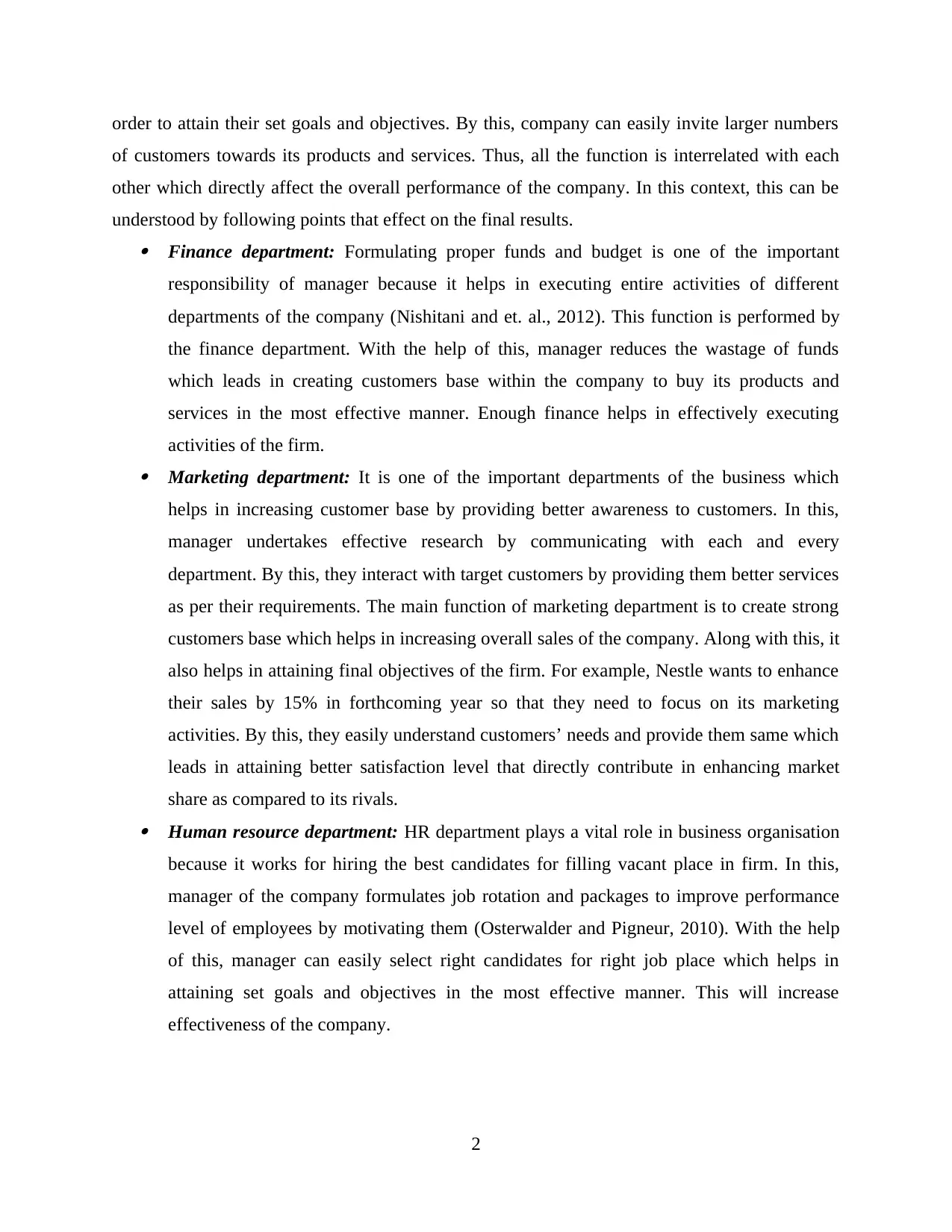
order to attain their set goals and objectives. By this, company can easily invite larger numbers
of customers towards its products and services. Thus, all the function is interrelated with each
other which directly affect the overall performance of the company. In this context, this can be
understood by following points that effect on the final results. Finance department: Formulating proper funds and budget is one of the important
responsibility of manager because it helps in executing entire activities of different
departments of the company (Nishitani and et. al., 2012). This function is performed by
the finance department. With the help of this, manager reduces the wastage of funds
which leads in creating customers base within the company to buy its products and
services in the most effective manner. Enough finance helps in effectively executing
activities of the firm. Marketing department: It is one of the important departments of the business which
helps in increasing customer base by providing better awareness to customers. In this,
manager undertakes effective research by communicating with each and every
department. By this, they interact with target customers by providing them better services
as per their requirements. The main function of marketing department is to create strong
customers base which helps in increasing overall sales of the company. Along with this, it
also helps in attaining final objectives of the firm. For example, Nestle wants to enhance
their sales by 15% in forthcoming year so that they need to focus on its marketing
activities. By this, they easily understand customers’ needs and provide them same which
leads in attaining better satisfaction level that directly contribute in enhancing market
share as compared to its rivals. Human resource department: HR department plays a vital role in business organisation
because it works for hiring the best candidates for filling vacant place in firm. In this,
manager of the company formulates job rotation and packages to improve performance
level of employees by motivating them (Osterwalder and Pigneur, 2010). With the help
of this, manager can easily select right candidates for right job place which helps in
attaining set goals and objectives in the most effective manner. This will increase
effectiveness of the company.
2
of customers towards its products and services. Thus, all the function is interrelated with each
other which directly affect the overall performance of the company. In this context, this can be
understood by following points that effect on the final results. Finance department: Formulating proper funds and budget is one of the important
responsibility of manager because it helps in executing entire activities of different
departments of the company (Nishitani and et. al., 2012). This function is performed by
the finance department. With the help of this, manager reduces the wastage of funds
which leads in creating customers base within the company to buy its products and
services in the most effective manner. Enough finance helps in effectively executing
activities of the firm. Marketing department: It is one of the important departments of the business which
helps in increasing customer base by providing better awareness to customers. In this,
manager undertakes effective research by communicating with each and every
department. By this, they interact with target customers by providing them better services
as per their requirements. The main function of marketing department is to create strong
customers base which helps in increasing overall sales of the company. Along with this, it
also helps in attaining final objectives of the firm. For example, Nestle wants to enhance
their sales by 15% in forthcoming year so that they need to focus on its marketing
activities. By this, they easily understand customers’ needs and provide them same which
leads in attaining better satisfaction level that directly contribute in enhancing market
share as compared to its rivals. Human resource department: HR department plays a vital role in business organisation
because it works for hiring the best candidates for filling vacant place in firm. In this,
manager of the company formulates job rotation and packages to improve performance
level of employees by motivating them (Osterwalder and Pigneur, 2010). With the help
of this, manager can easily select right candidates for right job place which helps in
attaining set goals and objectives in the most effective manner. This will increase
effectiveness of the company.
2
Paraphrase This Document
Need a fresh take? Get an instant paraphrase of this document with our AI Paraphraser
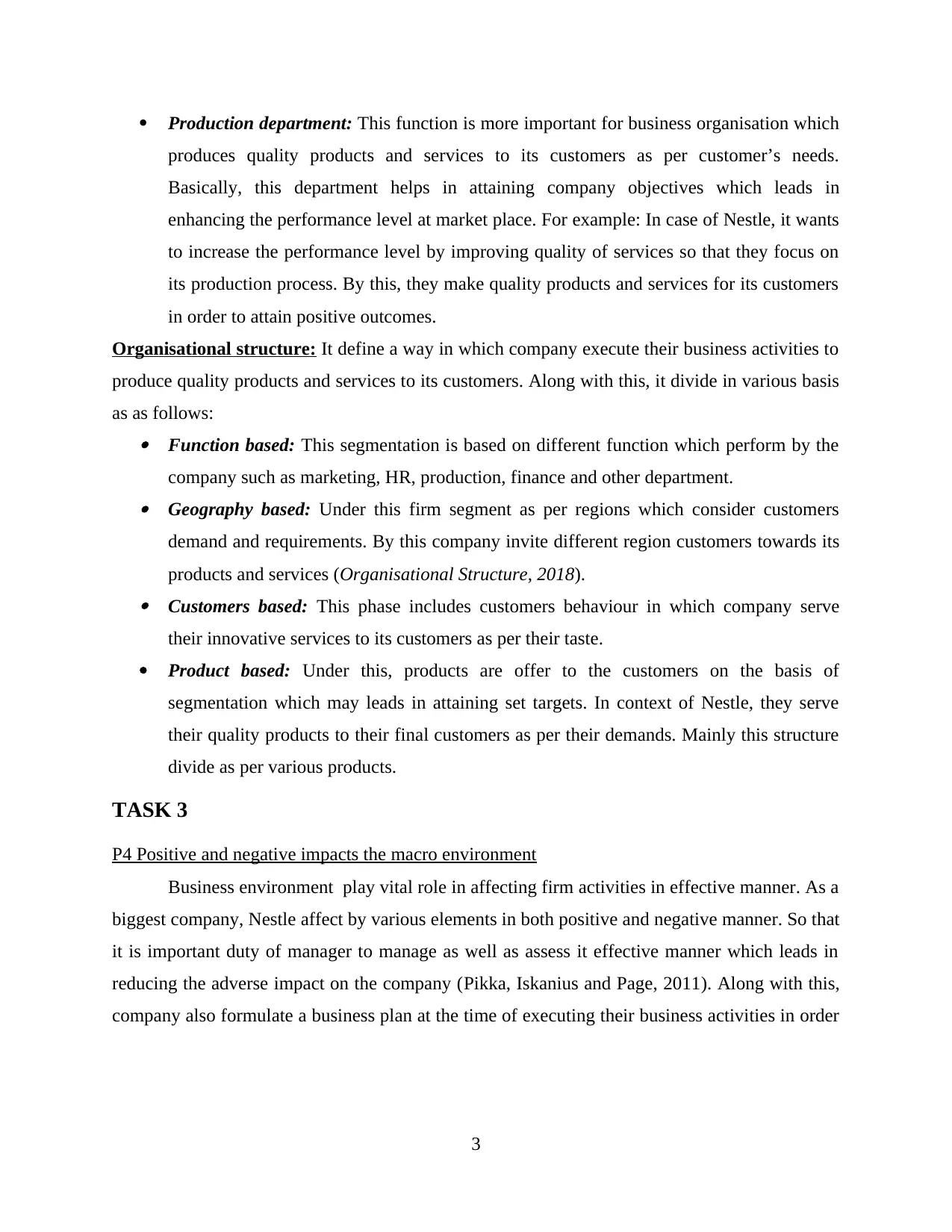
Production department: This function is more important for business organisation which
produces quality products and services to its customers as per customer’s needs.
Basically, this department helps in attaining company objectives which leads in
enhancing the performance level at market place. For example: In case of Nestle, it wants
to increase the performance level by improving quality of services so that they focus on
its production process. By this, they make quality products and services for its customers
in order to attain positive outcomes.
Organisational structure: It define a way in which company execute their business activities to
produce quality products and services to its customers. Along with this, it divide in various basis
as as follows: Function based: This segmentation is based on different function which perform by the
company such as marketing, HR, production, finance and other department. Geography based: Under this firm segment as per regions which consider customers
demand and requirements. By this company invite different region customers towards its
products and services (Organisational Structure, 2018). Customers based: This phase includes customers behaviour in which company serve
their innovative services to its customers as per their taste.
Product based: Under this, products are offer to the customers on the basis of
segmentation which may leads in attaining set targets. In context of Nestle, they serve
their quality products to their final customers as per their demands. Mainly this structure
divide as per various products.
TASK 3
P4 Positive and negative impacts the macro environment
Business environment play vital role in affecting firm activities in effective manner. As a
biggest company, Nestle affect by various elements in both positive and negative manner. So that
it is important duty of manager to manage as well as assess it effective manner which leads in
reducing the adverse impact on the company (Pikka, Iskanius and Page, 2011). Along with this,
company also formulate a business plan at the time of executing their business activities in order
3
produces quality products and services to its customers as per customer’s needs.
Basically, this department helps in attaining company objectives which leads in
enhancing the performance level at market place. For example: In case of Nestle, it wants
to increase the performance level by improving quality of services so that they focus on
its production process. By this, they make quality products and services for its customers
in order to attain positive outcomes.
Organisational structure: It define a way in which company execute their business activities to
produce quality products and services to its customers. Along with this, it divide in various basis
as as follows: Function based: This segmentation is based on different function which perform by the
company such as marketing, HR, production, finance and other department. Geography based: Under this firm segment as per regions which consider customers
demand and requirements. By this company invite different region customers towards its
products and services (Organisational Structure, 2018). Customers based: This phase includes customers behaviour in which company serve
their innovative services to its customers as per their taste.
Product based: Under this, products are offer to the customers on the basis of
segmentation which may leads in attaining set targets. In context of Nestle, they serve
their quality products to their final customers as per their demands. Mainly this structure
divide as per various products.
TASK 3
P4 Positive and negative impacts the macro environment
Business environment play vital role in affecting firm activities in effective manner. As a
biggest company, Nestle affect by various elements in both positive and negative manner. So that
it is important duty of manager to manage as well as assess it effective manner which leads in
reducing the adverse impact on the company (Pikka, Iskanius and Page, 2011). Along with this,
company also formulate a business plan at the time of executing their business activities in order
3
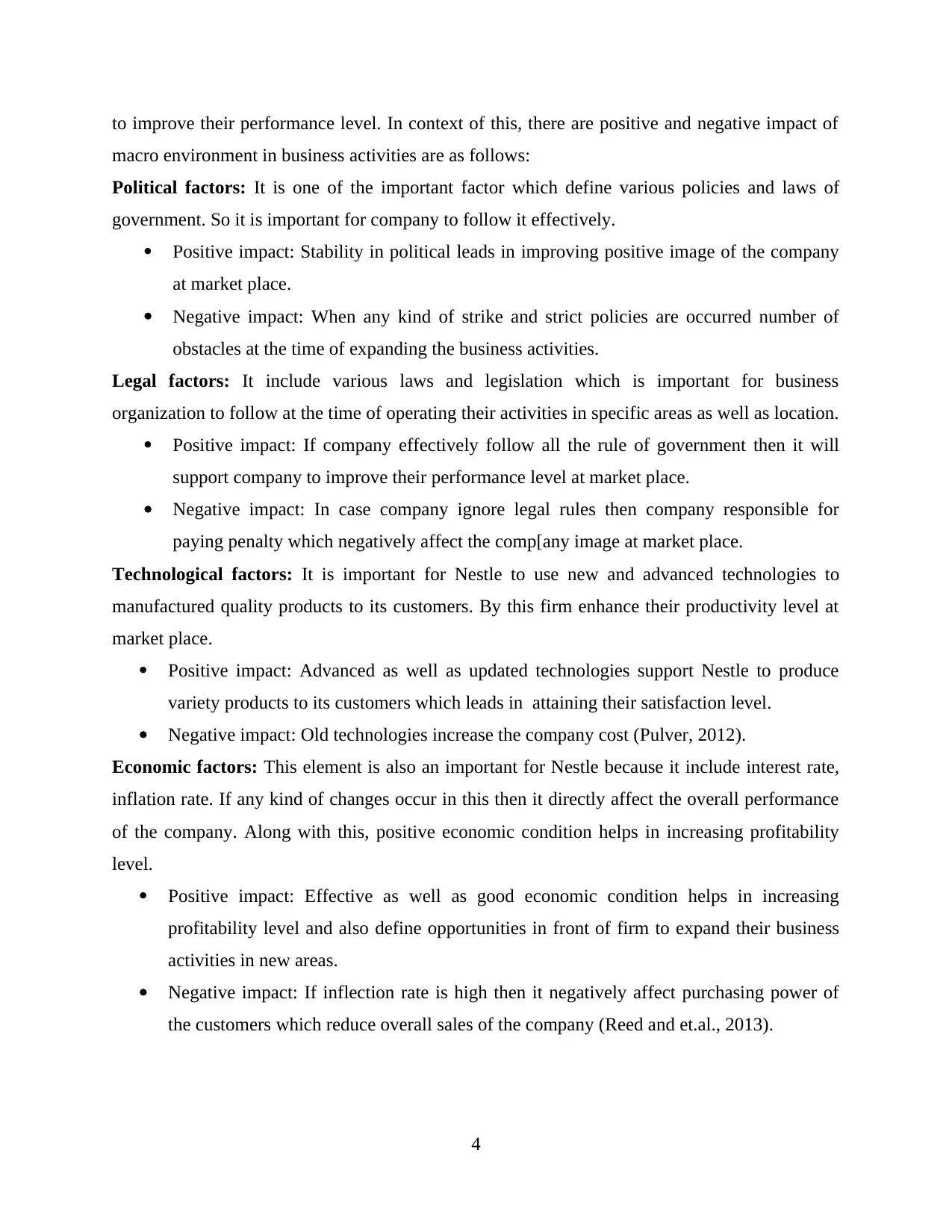
to improve their performance level. In context of this, there are positive and negative impact of
macro environment in business activities are as follows:
Political factors: It is one of the important factor which define various policies and laws of
government. So it is important for company to follow it effectively.
Positive impact: Stability in political leads in improving positive image of the company
at market place.
Negative impact: When any kind of strike and strict policies are occurred number of
obstacles at the time of expanding the business activities.
Legal factors: It include various laws and legislation which is important for business
organization to follow at the time of operating their activities in specific areas as well as location.
Positive impact: If company effectively follow all the rule of government then it will
support company to improve their performance level at market place.
Negative impact: In case company ignore legal rules then company responsible for
paying penalty which negatively affect the comp[any image at market place.
Technological factors: It is important for Nestle to use new and advanced technologies to
manufactured quality products to its customers. By this firm enhance their productivity level at
market place.
Positive impact: Advanced as well as updated technologies support Nestle to produce
variety products to its customers which leads in attaining their satisfaction level.
Negative impact: Old technologies increase the company cost (Pulver, 2012).
Economic factors: This element is also an important for Nestle because it include interest rate,
inflation rate. If any kind of changes occur in this then it directly affect the overall performance
of the company. Along with this, positive economic condition helps in increasing profitability
level.
Positive impact: Effective as well as good economic condition helps in increasing
profitability level and also define opportunities in front of firm to expand their business
activities in new areas.
Negative impact: If inflection rate is high then it negatively affect purchasing power of
the customers which reduce overall sales of the company (Reed and et.al., 2013).
4
macro environment in business activities are as follows:
Political factors: It is one of the important factor which define various policies and laws of
government. So it is important for company to follow it effectively.
Positive impact: Stability in political leads in improving positive image of the company
at market place.
Negative impact: When any kind of strike and strict policies are occurred number of
obstacles at the time of expanding the business activities.
Legal factors: It include various laws and legislation which is important for business
organization to follow at the time of operating their activities in specific areas as well as location.
Positive impact: If company effectively follow all the rule of government then it will
support company to improve their performance level at market place.
Negative impact: In case company ignore legal rules then company responsible for
paying penalty which negatively affect the comp[any image at market place.
Technological factors: It is important for Nestle to use new and advanced technologies to
manufactured quality products to its customers. By this firm enhance their productivity level at
market place.
Positive impact: Advanced as well as updated technologies support Nestle to produce
variety products to its customers which leads in attaining their satisfaction level.
Negative impact: Old technologies increase the company cost (Pulver, 2012).
Economic factors: This element is also an important for Nestle because it include interest rate,
inflation rate. If any kind of changes occur in this then it directly affect the overall performance
of the company. Along with this, positive economic condition helps in increasing profitability
level.
Positive impact: Effective as well as good economic condition helps in increasing
profitability level and also define opportunities in front of firm to expand their business
activities in new areas.
Negative impact: If inflection rate is high then it negatively affect purchasing power of
the customers which reduce overall sales of the company (Reed and et.al., 2013).
4
⊘ This is a preview!⊘
Do you want full access?
Subscribe today to unlock all pages.

Trusted by 1+ million students worldwide
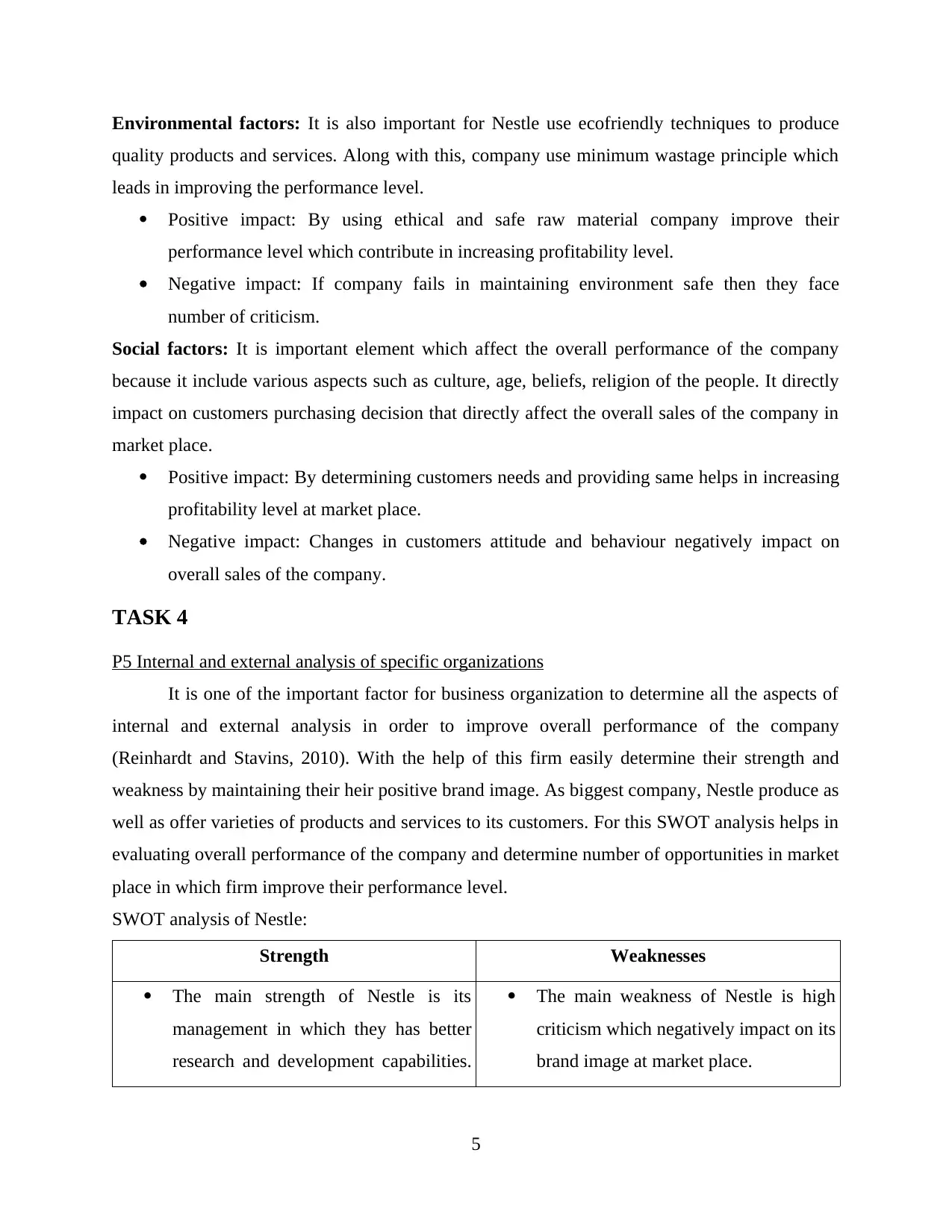
Environmental factors: It is also important for Nestle use ecofriendly techniques to produce
quality products and services. Along with this, company use minimum wastage principle which
leads in improving the performance level.
Positive impact: By using ethical and safe raw material company improve their
performance level which contribute in increasing profitability level.
Negative impact: If company fails in maintaining environment safe then they face
number of criticism.
Social factors: It is important element which affect the overall performance of the company
because it include various aspects such as culture, age, beliefs, religion of the people. It directly
impact on customers purchasing decision that directly affect the overall sales of the company in
market place.
Positive impact: By determining customers needs and providing same helps in increasing
profitability level at market place.
Negative impact: Changes in customers attitude and behaviour negatively impact on
overall sales of the company.
TASK 4
P5 Internal and external analysis of specific organizations
It is one of the important factor for business organization to determine all the aspects of
internal and external analysis in order to improve overall performance of the company
(Reinhardt and Stavins, 2010). With the help of this firm easily determine their strength and
weakness by maintaining their heir positive brand image. As biggest company, Nestle produce as
well as offer varieties of products and services to its customers. For this SWOT analysis helps in
evaluating overall performance of the company and determine number of opportunities in market
place in which firm improve their performance level.
SWOT analysis of Nestle:
Strength Weaknesses
The main strength of Nestle is its
management in which they has better
research and development capabilities.
The main weakness of Nestle is high
criticism which negatively impact on its
brand image at market place.
5
quality products and services. Along with this, company use minimum wastage principle which
leads in improving the performance level.
Positive impact: By using ethical and safe raw material company improve their
performance level which contribute in increasing profitability level.
Negative impact: If company fails in maintaining environment safe then they face
number of criticism.
Social factors: It is important element which affect the overall performance of the company
because it include various aspects such as culture, age, beliefs, religion of the people. It directly
impact on customers purchasing decision that directly affect the overall sales of the company in
market place.
Positive impact: By determining customers needs and providing same helps in increasing
profitability level at market place.
Negative impact: Changes in customers attitude and behaviour negatively impact on
overall sales of the company.
TASK 4
P5 Internal and external analysis of specific organizations
It is one of the important factor for business organization to determine all the aspects of
internal and external analysis in order to improve overall performance of the company
(Reinhardt and Stavins, 2010). With the help of this firm easily determine their strength and
weakness by maintaining their heir positive brand image. As biggest company, Nestle produce as
well as offer varieties of products and services to its customers. For this SWOT analysis helps in
evaluating overall performance of the company and determine number of opportunities in market
place in which firm improve their performance level.
SWOT analysis of Nestle:
Strength Weaknesses
The main strength of Nestle is its
management in which they has better
research and development capabilities.
The main weakness of Nestle is high
criticism which negatively impact on its
brand image at market place.
5
Paraphrase This Document
Need a fresh take? Get an instant paraphrase of this document with our AI Paraphraser
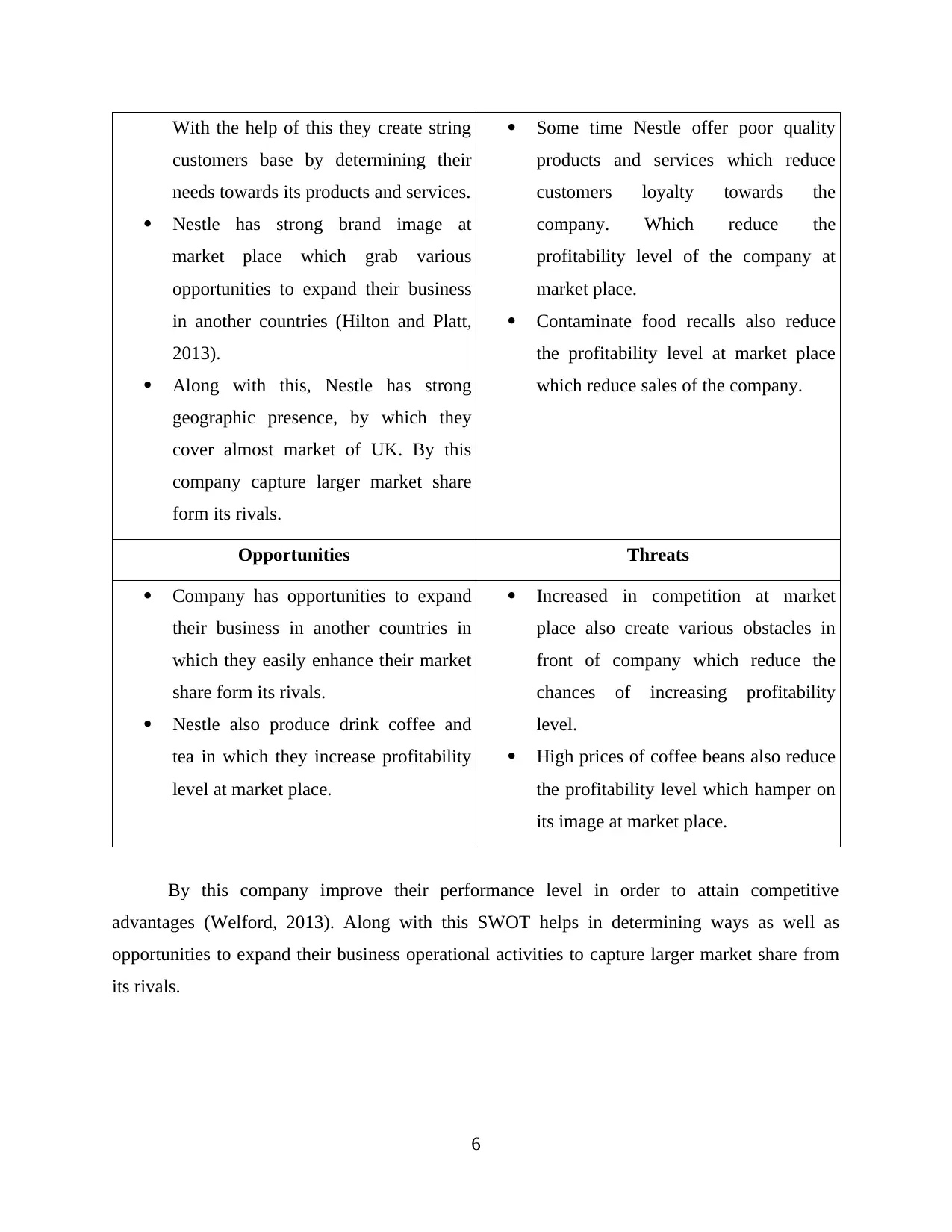
With the help of this they create string
customers base by determining their
needs towards its products and services.
Nestle has strong brand image at
market place which grab various
opportunities to expand their business
in another countries (Hilton and Platt,
2013).
Along with this, Nestle has strong
geographic presence, by which they
cover almost market of UK. By this
company capture larger market share
form its rivals.
Some time Nestle offer poor quality
products and services which reduce
customers loyalty towards the
company. Which reduce the
profitability level of the company at
market place.
Contaminate food recalls also reduce
the profitability level at market place
which reduce sales of the company.
Opportunities Threats
Company has opportunities to expand
their business in another countries in
which they easily enhance their market
share form its rivals.
Nestle also produce drink coffee and
tea in which they increase profitability
level at market place.
Increased in competition at market
place also create various obstacles in
front of company which reduce the
chances of increasing profitability
level.
High prices of coffee beans also reduce
the profitability level which hamper on
its image at market place.
By this company improve their performance level in order to attain competitive
advantages (Welford, 2013). Along with this SWOT helps in determining ways as well as
opportunities to expand their business operational activities to capture larger market share from
its rivals.
6
customers base by determining their
needs towards its products and services.
Nestle has strong brand image at
market place which grab various
opportunities to expand their business
in another countries (Hilton and Platt,
2013).
Along with this, Nestle has strong
geographic presence, by which they
cover almost market of UK. By this
company capture larger market share
form its rivals.
Some time Nestle offer poor quality
products and services which reduce
customers loyalty towards the
company. Which reduce the
profitability level of the company at
market place.
Contaminate food recalls also reduce
the profitability level at market place
which reduce sales of the company.
Opportunities Threats
Company has opportunities to expand
their business in another countries in
which they easily enhance their market
share form its rivals.
Nestle also produce drink coffee and
tea in which they increase profitability
level at market place.
Increased in competition at market
place also create various obstacles in
front of company which reduce the
chances of increasing profitability
level.
High prices of coffee beans also reduce
the profitability level which hamper on
its image at market place.
By this company improve their performance level in order to attain competitive
advantages (Welford, 2013). Along with this SWOT helps in determining ways as well as
opportunities to expand their business operational activities to capture larger market share from
its rivals.
6
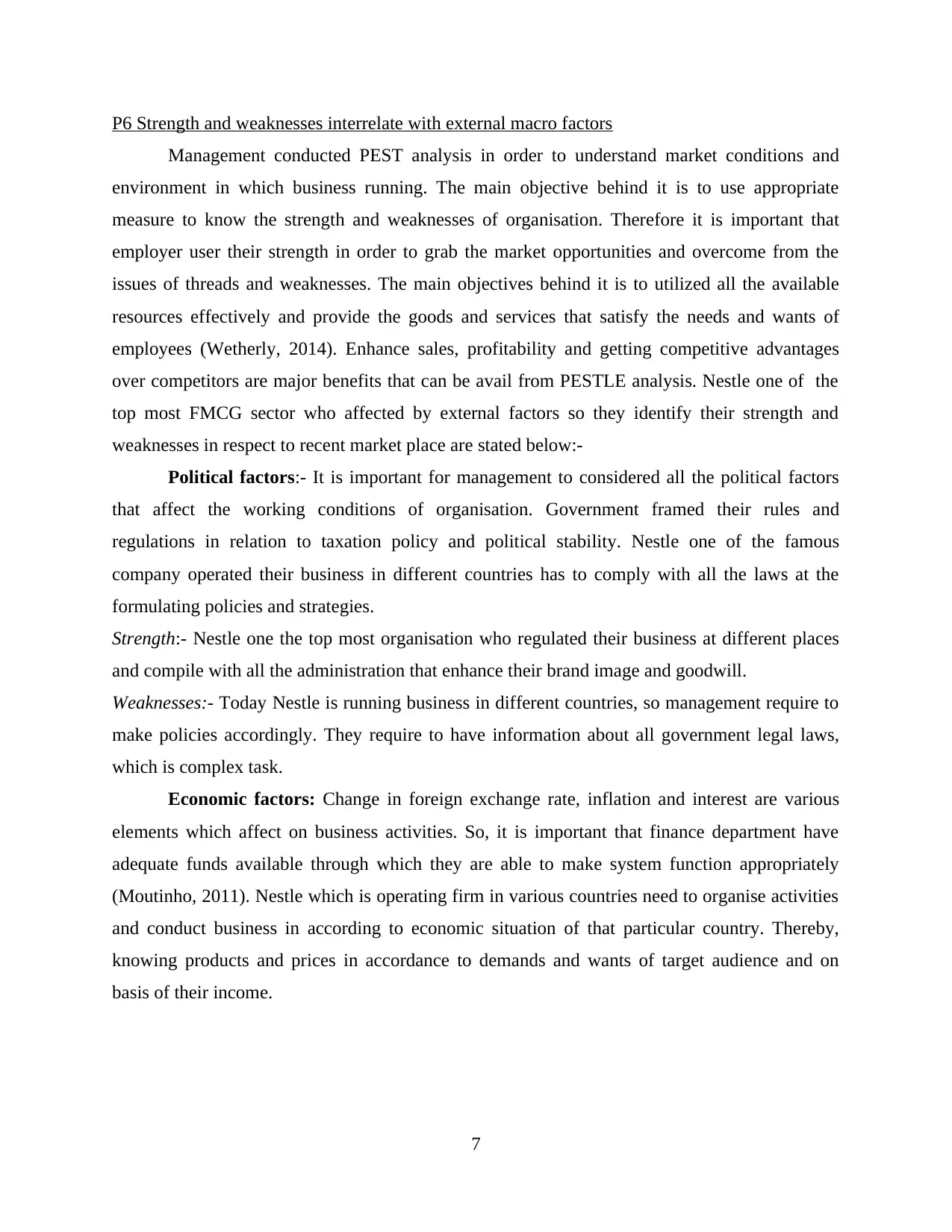
P6 Strength and weaknesses interrelate with external macro factors
Management conducted PEST analysis in order to understand market conditions and
environment in which business running. The main objective behind it is to use appropriate
measure to know the strength and weaknesses of organisation. Therefore it is important that
employer user their strength in order to grab the market opportunities and overcome from the
issues of threads and weaknesses. The main objectives behind it is to utilized all the available
resources effectively and provide the goods and services that satisfy the needs and wants of
employees (Wetherly, 2014). Enhance sales, profitability and getting competitive advantages
over competitors are major benefits that can be avail from PESTLE analysis. Nestle one of the
top most FMCG sector who affected by external factors so they identify their strength and
weaknesses in respect to recent market place are stated below:-
Political factors:- It is important for management to considered all the political factors
that affect the working conditions of organisation. Government framed their rules and
regulations in relation to taxation policy and political stability. Nestle one of the famous
company operated their business in different countries has to comply with all the laws at the
formulating policies and strategies.
Strength:- Nestle one the top most organisation who regulated their business at different places
and compile with all the administration that enhance their brand image and goodwill.
Weaknesses:- Today Nestle is running business in different countries, so management require to
make policies accordingly. They require to have information about all government legal laws,
which is complex task.
Economic factors: Change in foreign exchange rate, inflation and interest are various
elements which affect on business activities. So, it is important that finance department have
adequate funds available through which they are able to make system function appropriately
(Moutinho, 2011). Nestle which is operating firm in various countries need to organise activities
and conduct business in according to economic situation of that particular country. Thereby,
knowing products and prices in accordance to demands and wants of target audience and on
basis of their income.
7
Management conducted PEST analysis in order to understand market conditions and
environment in which business running. The main objective behind it is to use appropriate
measure to know the strength and weaknesses of organisation. Therefore it is important that
employer user their strength in order to grab the market opportunities and overcome from the
issues of threads and weaknesses. The main objectives behind it is to utilized all the available
resources effectively and provide the goods and services that satisfy the needs and wants of
employees (Wetherly, 2014). Enhance sales, profitability and getting competitive advantages
over competitors are major benefits that can be avail from PESTLE analysis. Nestle one of the
top most FMCG sector who affected by external factors so they identify their strength and
weaknesses in respect to recent market place are stated below:-
Political factors:- It is important for management to considered all the political factors
that affect the working conditions of organisation. Government framed their rules and
regulations in relation to taxation policy and political stability. Nestle one of the famous
company operated their business in different countries has to comply with all the laws at the
formulating policies and strategies.
Strength:- Nestle one the top most organisation who regulated their business at different places
and compile with all the administration that enhance their brand image and goodwill.
Weaknesses:- Today Nestle is running business in different countries, so management require to
make policies accordingly. They require to have information about all government legal laws,
which is complex task.
Economic factors: Change in foreign exchange rate, inflation and interest are various
elements which affect on business activities. So, it is important that finance department have
adequate funds available through which they are able to make system function appropriately
(Moutinho, 2011). Nestle which is operating firm in various countries need to organise activities
and conduct business in according to economic situation of that particular country. Thereby,
knowing products and prices in accordance to demands and wants of target audience and on
basis of their income.
7
⊘ This is a preview!⊘
Do you want full access?
Subscribe today to unlock all pages.

Trusted by 1+ million students worldwide
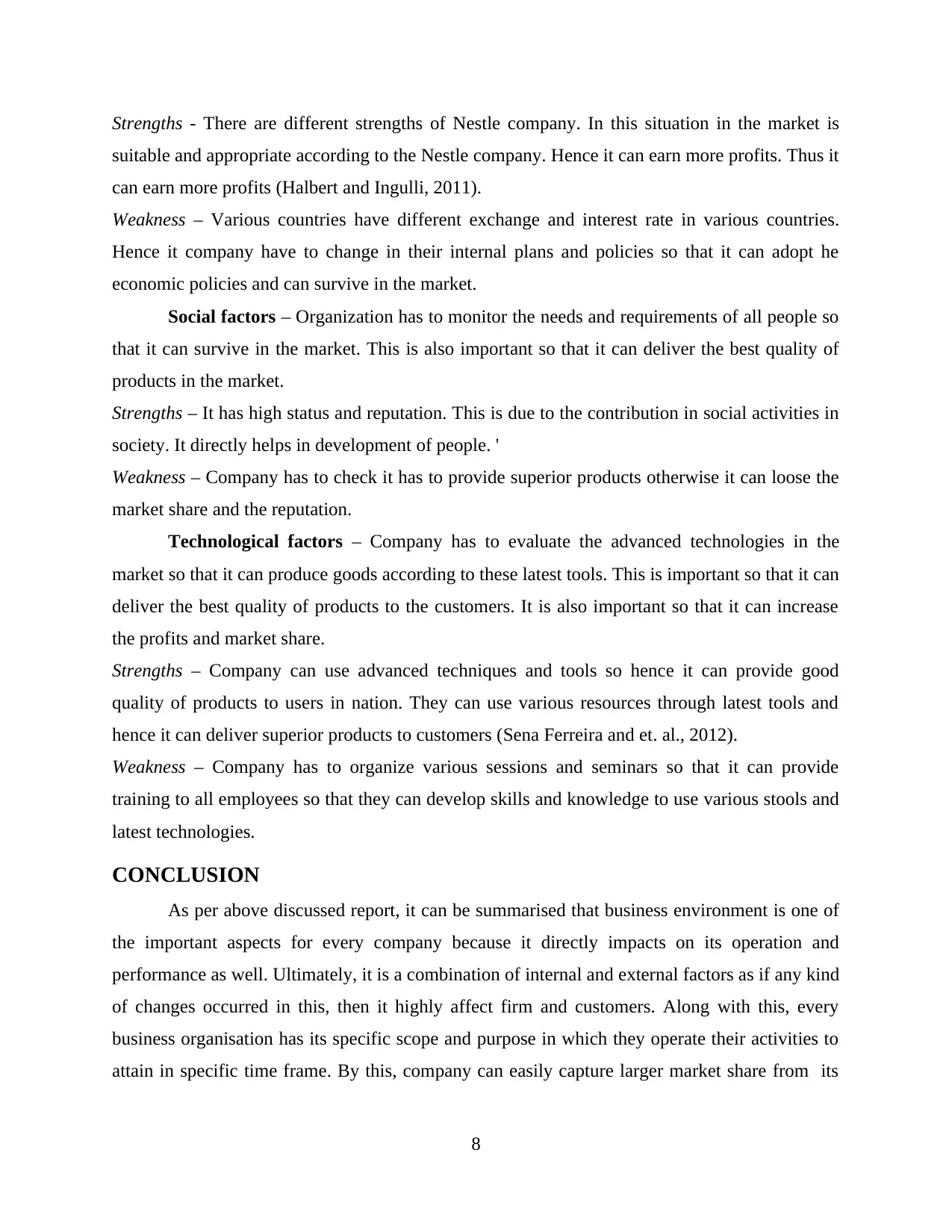
Strengths - There are different strengths of Nestle company. In this situation in the market is
suitable and appropriate according to the Nestle company. Hence it can earn more profits. Thus it
can earn more profits (Halbert and Ingulli, 2011).
Weakness – Various countries have different exchange and interest rate in various countries.
Hence it company have to change in their internal plans and policies so that it can adopt he
economic policies and can survive in the market.
Social factors – Organization has to monitor the needs and requirements of all people so
that it can survive in the market. This is also important so that it can deliver the best quality of
products in the market.
Strengths – It has high status and reputation. This is due to the contribution in social activities in
society. It directly helps in development of people. '
Weakness – Company has to check it has to provide superior products otherwise it can loose the
market share and the reputation.
Technological factors – Company has to evaluate the advanced technologies in the
market so that it can produce goods according to these latest tools. This is important so that it can
deliver the best quality of products to the customers. It is also important so that it can increase
the profits and market share.
Strengths – Company can use advanced techniques and tools so hence it can provide good
quality of products to users in nation. They can use various resources through latest tools and
hence it can deliver superior products to customers (Sena Ferreira and et. al., 2012).
Weakness – Company has to organize various sessions and seminars so that it can provide
training to all employees so that they can develop skills and knowledge to use various stools and
latest technologies.
CONCLUSION
As per above discussed report, it can be summarised that business environment is one of
the important aspects for every company because it directly impacts on its operation and
performance as well. Ultimately, it is a combination of internal and external factors as if any kind
of changes occurred in this, then it highly affect firm and customers. Along with this, every
business organisation has its specific scope and purpose in which they operate their activities to
attain in specific time frame. By this, company can easily capture larger market share from its
8
suitable and appropriate according to the Nestle company. Hence it can earn more profits. Thus it
can earn more profits (Halbert and Ingulli, 2011).
Weakness – Various countries have different exchange and interest rate in various countries.
Hence it company have to change in their internal plans and policies so that it can adopt he
economic policies and can survive in the market.
Social factors – Organization has to monitor the needs and requirements of all people so
that it can survive in the market. This is also important so that it can deliver the best quality of
products in the market.
Strengths – It has high status and reputation. This is due to the contribution in social activities in
society. It directly helps in development of people. '
Weakness – Company has to check it has to provide superior products otherwise it can loose the
market share and the reputation.
Technological factors – Company has to evaluate the advanced technologies in the
market so that it can produce goods according to these latest tools. This is important so that it can
deliver the best quality of products to the customers. It is also important so that it can increase
the profits and market share.
Strengths – Company can use advanced techniques and tools so hence it can provide good
quality of products to users in nation. They can use various resources through latest tools and
hence it can deliver superior products to customers (Sena Ferreira and et. al., 2012).
Weakness – Company has to organize various sessions and seminars so that it can provide
training to all employees so that they can develop skills and knowledge to use various stools and
latest technologies.
CONCLUSION
As per above discussed report, it can be summarised that business environment is one of
the important aspects for every company because it directly impacts on its operation and
performance as well. Ultimately, it is a combination of internal and external factors as if any kind
of changes occurred in this, then it highly affect firm and customers. Along with this, every
business organisation has its specific scope and purpose in which they operate their activities to
attain in specific time frame. By this, company can easily capture larger market share from its
8
Paraphrase This Document
Need a fresh take? Get an instant paraphrase of this document with our AI Paraphraser
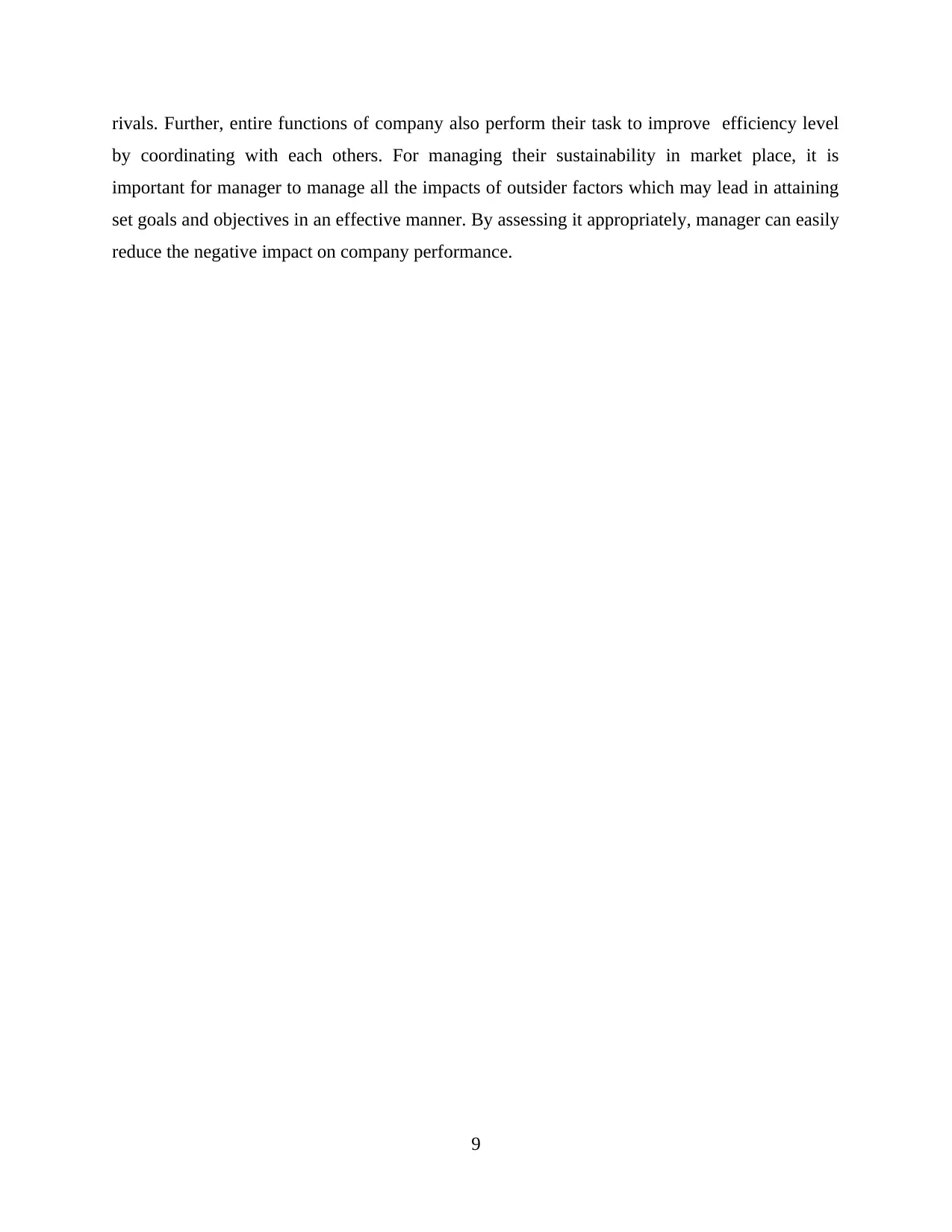
rivals. Further, entire functions of company also perform their task to improve efficiency level
by coordinating with each others. For managing their sustainability in market place, it is
important for manager to manage all the impacts of outsider factors which may lead in attaining
set goals and objectives in an effective manner. By assessing it appropriately, manager can easily
reduce the negative impact on company performance.
9
by coordinating with each others. For managing their sustainability in market place, it is
important for manager to manage all the impacts of outsider factors which may lead in attaining
set goals and objectives in an effective manner. By assessing it appropriately, manager can easily
reduce the negative impact on company performance.
9
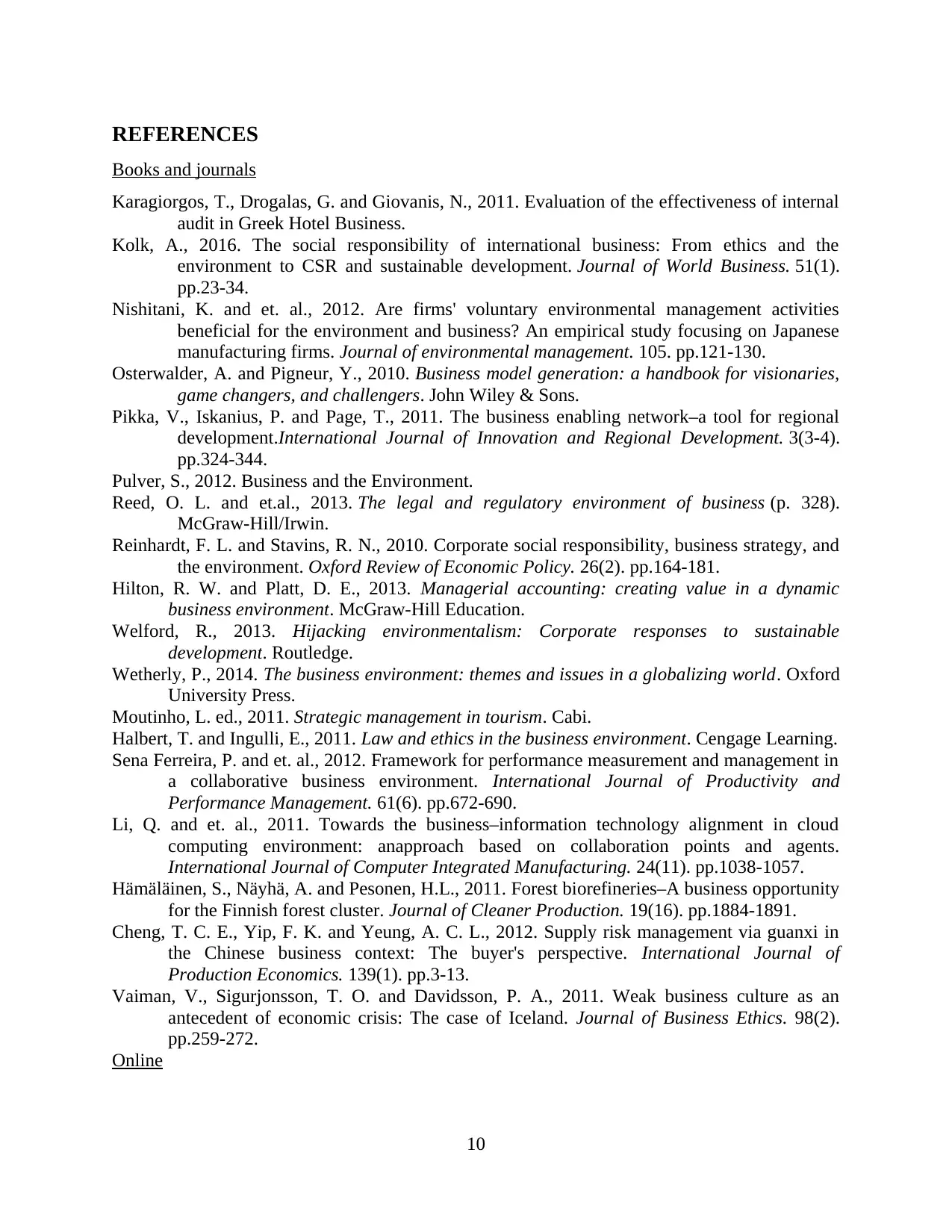
REFERENCES
Books and journals
Karagiorgos, T., Drogalas, G. and Giovanis, N., 2011. Evaluation of the effectiveness of internal
audit in Greek Hotel Business.
Kolk, A., 2016. The social responsibility of international business: From ethics and the
environment to CSR and sustainable development. Journal of World Business. 51(1).
pp.23-34.
Nishitani, K. and et. al., 2012. Are firms' voluntary environmental management activities
beneficial for the environment and business? An empirical study focusing on Japanese
manufacturing firms. Journal of environmental management. 105. pp.121-130.
Osterwalder, A. and Pigneur, Y., 2010. Business model generation: a handbook for visionaries,
game changers, and challengers. John Wiley & Sons.
Pikka, V., Iskanius, P. and Page, T., 2011. The business enabling network–a tool for regional
development.International Journal of Innovation and Regional Development. 3(3-4).
pp.324-344.
Pulver, S., 2012. Business and the Environment.
Reed, O. L. and et.al., 2013. The legal and regulatory environment of business (p. 328).
McGraw-Hill/Irwin.
Reinhardt, F. L. and Stavins, R. N., 2010. Corporate social responsibility, business strategy, and
the environment. Oxford Review of Economic Policy. 26(2). pp.164-181.
Hilton, R. W. and Platt, D. E., 2013. Managerial accounting: creating value in a dynamic
business environment. McGraw-Hill Education.
Welford, R., 2013. Hijacking environmentalism: Corporate responses to sustainable
development. Routledge.
Wetherly, P., 2014. The business environment: themes and issues in a globalizing world. Oxford
University Press.
Moutinho, L. ed., 2011. Strategic management in tourism. Cabi.
Halbert, T. and Ingulli, E., 2011. Law and ethics in the business environment. Cengage Learning.
Sena Ferreira, P. and et. al., 2012. Framework for performance measurement and management in
a collaborative business environment. International Journal of Productivity and
Performance Management. 61(6). pp.672-690.
Li, Q. and et. al., 2011. Towards the business–information technology alignment in cloud
computing environment: anapproach based on collaboration points and agents.
International Journal of Computer Integrated Manufacturing. 24(11). pp.1038-1057.
Hämäläinen, S., Näyhä, A. and Pesonen, H.L., 2011. Forest biorefineries–A business opportunity
for the Finnish forest cluster. Journal of Cleaner Production. 19(16). pp.1884-1891.
Cheng, T. C. E., Yip, F. K. and Yeung, A. C. L., 2012. Supply risk management via guanxi in
the Chinese business context: The buyer's perspective. International Journal of
Production Economics. 139(1). pp.3-13.
Vaiman, V., Sigurjonsson, T. O. and Davidsson, P. A., 2011. Weak business culture as an
antecedent of economic crisis: The case of Iceland. Journal of Business Ethics. 98(2).
pp.259-272.
Online
10
Books and journals
Karagiorgos, T., Drogalas, G. and Giovanis, N., 2011. Evaluation of the effectiveness of internal
audit in Greek Hotel Business.
Kolk, A., 2016. The social responsibility of international business: From ethics and the
environment to CSR and sustainable development. Journal of World Business. 51(1).
pp.23-34.
Nishitani, K. and et. al., 2012. Are firms' voluntary environmental management activities
beneficial for the environment and business? An empirical study focusing on Japanese
manufacturing firms. Journal of environmental management. 105. pp.121-130.
Osterwalder, A. and Pigneur, Y., 2010. Business model generation: a handbook for visionaries,
game changers, and challengers. John Wiley & Sons.
Pikka, V., Iskanius, P. and Page, T., 2011. The business enabling network–a tool for regional
development.International Journal of Innovation and Regional Development. 3(3-4).
pp.324-344.
Pulver, S., 2012. Business and the Environment.
Reed, O. L. and et.al., 2013. The legal and regulatory environment of business (p. 328).
McGraw-Hill/Irwin.
Reinhardt, F. L. and Stavins, R. N., 2010. Corporate social responsibility, business strategy, and
the environment. Oxford Review of Economic Policy. 26(2). pp.164-181.
Hilton, R. W. and Platt, D. E., 2013. Managerial accounting: creating value in a dynamic
business environment. McGraw-Hill Education.
Welford, R., 2013. Hijacking environmentalism: Corporate responses to sustainable
development. Routledge.
Wetherly, P., 2014. The business environment: themes and issues in a globalizing world. Oxford
University Press.
Moutinho, L. ed., 2011. Strategic management in tourism. Cabi.
Halbert, T. and Ingulli, E., 2011. Law and ethics in the business environment. Cengage Learning.
Sena Ferreira, P. and et. al., 2012. Framework for performance measurement and management in
a collaborative business environment. International Journal of Productivity and
Performance Management. 61(6). pp.672-690.
Li, Q. and et. al., 2011. Towards the business–information technology alignment in cloud
computing environment: anapproach based on collaboration points and agents.
International Journal of Computer Integrated Manufacturing. 24(11). pp.1038-1057.
Hämäläinen, S., Näyhä, A. and Pesonen, H.L., 2011. Forest biorefineries–A business opportunity
for the Finnish forest cluster. Journal of Cleaner Production. 19(16). pp.1884-1891.
Cheng, T. C. E., Yip, F. K. and Yeung, A. C. L., 2012. Supply risk management via guanxi in
the Chinese business context: The buyer's perspective. International Journal of
Production Economics. 139(1). pp.3-13.
Vaiman, V., Sigurjonsson, T. O. and Davidsson, P. A., 2011. Weak business culture as an
antecedent of economic crisis: The case of Iceland. Journal of Business Ethics. 98(2).
pp.259-272.
Online
10
⊘ This is a preview!⊘
Do you want full access?
Subscribe today to unlock all pages.

Trusted by 1+ million students worldwide
1 out of 13
Related Documents
Your All-in-One AI-Powered Toolkit for Academic Success.
+13062052269
info@desklib.com
Available 24*7 on WhatsApp / Email
![[object Object]](/_next/static/media/star-bottom.7253800d.svg)
Unlock your academic potential
Copyright © 2020–2025 A2Z Services. All Rights Reserved. Developed and managed by ZUCOL.





